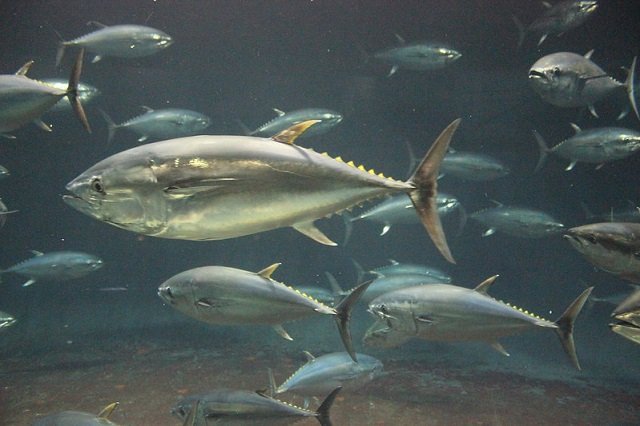Norway.- There is a growing interest in closed containment aquaculture (CCA). Many want to know more, and the questions are many: Why do we need CCA? What exactly is CCA? How widespread will they become?
”Closed containment aquaculture come in several varieties. Whether a large proportion of farmed salmon will be produced in closed containment farms in the future depends on which salmon farming structures the government will facilitate, whether fish farmers will be able to carry out production activities within that framework, and whether the market is willing to pay for it. There are both advantages and disadvantages with such closed containment facilities, and personally, I believe many different types of technology will be used for salmon farming operations”, says Åsa Espmark from Nofima.
Espmark is the director of the CtrlAQUA SFI, which is a centre for research-driven innovation in closed-containment farming systems. Here, 21 partners from the research, fish farming and supply industry sectors work together to make CCA solutions become an every-day shelf product by 2023.
“The reason why we are researching closed containment facilities is that the traditional method of open-net fish farming alone will not be sustainable in the future. The fish farming industry must find alternative ways to farm salmon. CCA will make it possible to farm salmon practically without salmon lice and escaped fish, as there will be a physical barrier between the fish and the sea so the lice cannot enter and fish cannot escape. We are now conducting research to find ways to make salmon thrive in such facilities”, says Espmark.
The solutions the CtrlAQUA researchers are working on are land-based facilities and semi-closed facilities at sea for production of salmon of up to 1 kg.
Why stop when the salmon reaches a weight of 1 kilogram?
”CtrlAQUA stops there as it is before the weight reaches one kilogram that we can do anything significant to strengthen the robustness, health and wellbeing of the fish. The rest is, to put it simply, basically a transport stage for the fish to grow bigger”, says Espmark.
Does the fact that not all salmon are kept in closed containment facilities until they are harvested have any negative environmental effects?
Stay Always Informed
Join our communities to instantly receive the most important news, reports, and analysis from the aquaculture industry.
“I doubt that. As a salmon is approaching the target weight of five kilograms, it requires far more space than when it is small. With closed-containment farming, the total Norwegian salmon production would require enormous land areas. It would also be very energy intensive and technologically challenging to operate an onshore fish farm with pumps and salt-water recycling, as salmon should preferably live in salt water as it matures”, says Espmark.
“I believe it will have a significant positive impact on the environment if we can reduce the amount of time the salmon spends in the sea by allowing it to spend more of its life in land-based facilities than it currently does”, she says.
Offshore fish farms as a complementary technology
Espmark is supported by Hans Bjelland of Sintef, who is Centre Director of the Exposed SFI. They are working with open-water fish pens in locations far from land, known as “exposed aquaculture”. Like CtrlAQUA it is an SFI for exploring the opportunities for the future of aquaculture technology.
“The reasons for working with developing fish farming operations in exposed locations are that there is plenty of space; stable, good water conditions; and greater distance between each fish farming facility, which reduces the infection pressure. At the same time, ocean currents carry away fish faeces and uneaten feed.”
“If we are able to let salmon grow big on land before it’s transferred to sea, we can reduce the time spent at sea from the current 16-18 months down to 10 months, which means we can also avoid the two most severe winter months. Every third salmon that escapes does so during bad weather – and bad weather is more prevalent in winter”, says Bjelland.
Salmon that is to be transported to offshore facilities far from land must be able to endure hours of strong currents and more waves than the salmon placed in net pens in more sheltered environments.
“In the Exposed SFI we are doing a great deal of research on swimming capacity and behaviour. The SFIs are complementing each other in this regard. Whereas researchers in CtrlAQUA are researching health and production efficiency in fish farming in order to produce smolt that can survive the transition to the sea, we also need even more robust smolt that can survive the transition to a more demanding open-sea environment”, says Bjelland.
And finally – Why is the centre called CtrlAQUA?
“CtrlAQUA stands for control in aquaculture production. Being able to control the production environment is key to sustainable farming and healthy salmon in closed containment facilities”, says Espmark.
Source: CtrlAQUA
Editor at the digital magazine AquaHoy. He holds a degree in Aquaculture Biology from the National University of Santa (UNS) and a Master’s degree in Science and Innovation Management from the Polytechnic University of Valencia, with postgraduate diplomas in Business Innovation and Innovation Management. He possesses extensive experience in the aquaculture and fisheries sector, having led the Fisheries Innovation Unit of the National Program for Innovation in Fisheries and Aquaculture (PNIPA). He has served as a senior consultant in technology watch, an innovation project formulator and advisor, and a lecturer at UNS. He is a member of the Peruvian College of Biologists and was recognized by the World Aquaculture Society (WAS) in 2016 for his contribution to aquaculture.




